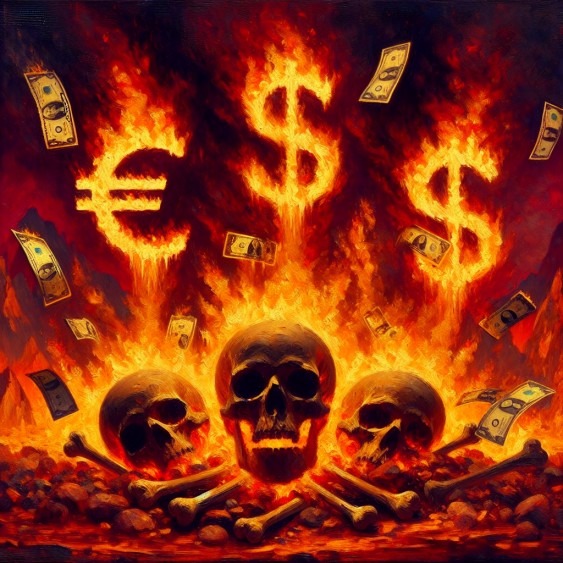BOJ Stuns Markets: Currency Wars Escalate with Negative Rates
Updated Jan 2024
The Bank of Japan (BOJ), in a surprising move that has sent shockwaves through global markets, has lowered its interest rates into negative territory. This move further emphasizes the escalating currency wars and the relentless race towards devaluation. Nations, one after the other, are debasing their currencies, hoping to gain a competitive edge in the global market. However, this strategy merely delays the inevitable, buying extra time in an economy far from optimal.
The unfavourable interest rates decision triggered a significant rally in the markets, demonstrating the impact of ‘hot money’ – short-term, speculative investment – on market trends. While critics argue that the Federal Reserve has exhausted its ammunition, the reality is that it can still create money out of thin air, enabling it to prop up the markets. Central bankers worldwide have now adopted this strategy, further intensifying the currency wars.
There’s no sign of rebellion from the masses, indicating that this financial game could continue for the foreseeable future. We are in the ‘devalue or die’ era, where nations feel compelled to follow the leader in currency devaluation. However, a divergence is inevitable at some point. Whether we will witness this shift in our lifetime remains uncertain, but the current escalation of currency wars is a clear indicator of the volatile economic landscape we navigate.
BOJ’s Unexpected Move: The Escalation of Currency Wars with Negative Rate
The BOJ (Bank of Japan) apparently understands that this economic recovery is nothing but rubbish as they lowered rates into negative territory. The currency wars are now raging, and the race to the bottom is gathering momentum; one nation after another debases its currency in the hopes of gaining a competitive edge. All this does is to buy a little extra time. The markets can continue trending higher even though economic conditions are far from optimal as the main driver is hot money.
Everyone witnessed the monster rally the markets experienced after the BOJ lowered rates. While many will state the Fed has run out of bullets, it still can create money out of thin air and use that to prop the markets up. Central bankers worldwide have now embraced this strategy. The masses are nowhere near revolting, so this game could continue for a long time. In the “devalue or die era”, most nations have no choice but to follow the leader. At some point, there will be a divergence, but on the same token, you might not be around to see that day.
The Fed is already backpedalling from the strong stance they took last year. Hot money saved this market by creating an illusion of stability, and it’s only hot money that can maintain this illusion. The Fed is fully aware of this. They have two options: maintain an environment that propels companies to take on more debt and use this money to purchase even larger amounts of their shares; this artificially boosts the EPS and also helps drive the market as the funds corporations are allocating to share buybacks is monstrous. In fact, it is set to surge over $1 trillion in 2016, a sum larger than many nations’ GDP. The second option is to take an even more aggressive stance and create another stimulus program.
Updated Game Plan Amidst Escalating Currency Wars
The dollar has recently seen a pullback, and Gold desperately attempts to signal that a bottom is in. Given the escalating currency wars, Gold could be a wise long-term investment. The principles of mass psychology and contrarian investing suggest that it’s time to pay attention to markets currently out of favour. Right now, the entire precious metals sector fits this description.
However, until Gold closes above $2100, it will remain in a trading range, with the potential to drop to the 1800 range. A monthly close above $2100 would likely indicate that a bottom has been established. As the currency wars intensify, the stock market is expected to be the primary beneficiary as it adjusts and prices in the inflation factor. Therefore, savvy investors should use strong pullbacks to open positions in robust stocks, such as WMT, HD, DE, TSM, INTC, IBM, AA, AXP, MCD, etc.
The Bank of Japan’s recent move to lower rates into negative territory has fueled the currency wars. This trend is expected to continue, with nations devaluing their currencies to gain a competitive edge. However, this strategy only buys time and does not address the underlying economic issues. Despite this, the markets can continue to trend higher due to the influence of hot money.
Originally published on February 6, 2016, with the latest update in Jan 2024.
Other articles
American economy recovery not real & funded via debt (Feb 5)
U.S Government lies: real unemployment rate 22.9% (Feb 4)
Fed raised rates & bonds Rally as predicted (Feb 3)
7 Reasons America’s Economic Recovery Is Not Real (Feb 1)
Stock Market Bears Slaughtered as Dow Mounts stunning rally (Jan 30)
Stock Market Crash, Dejavu 1987 or Bullish Buying opportunity (Jan 27)



